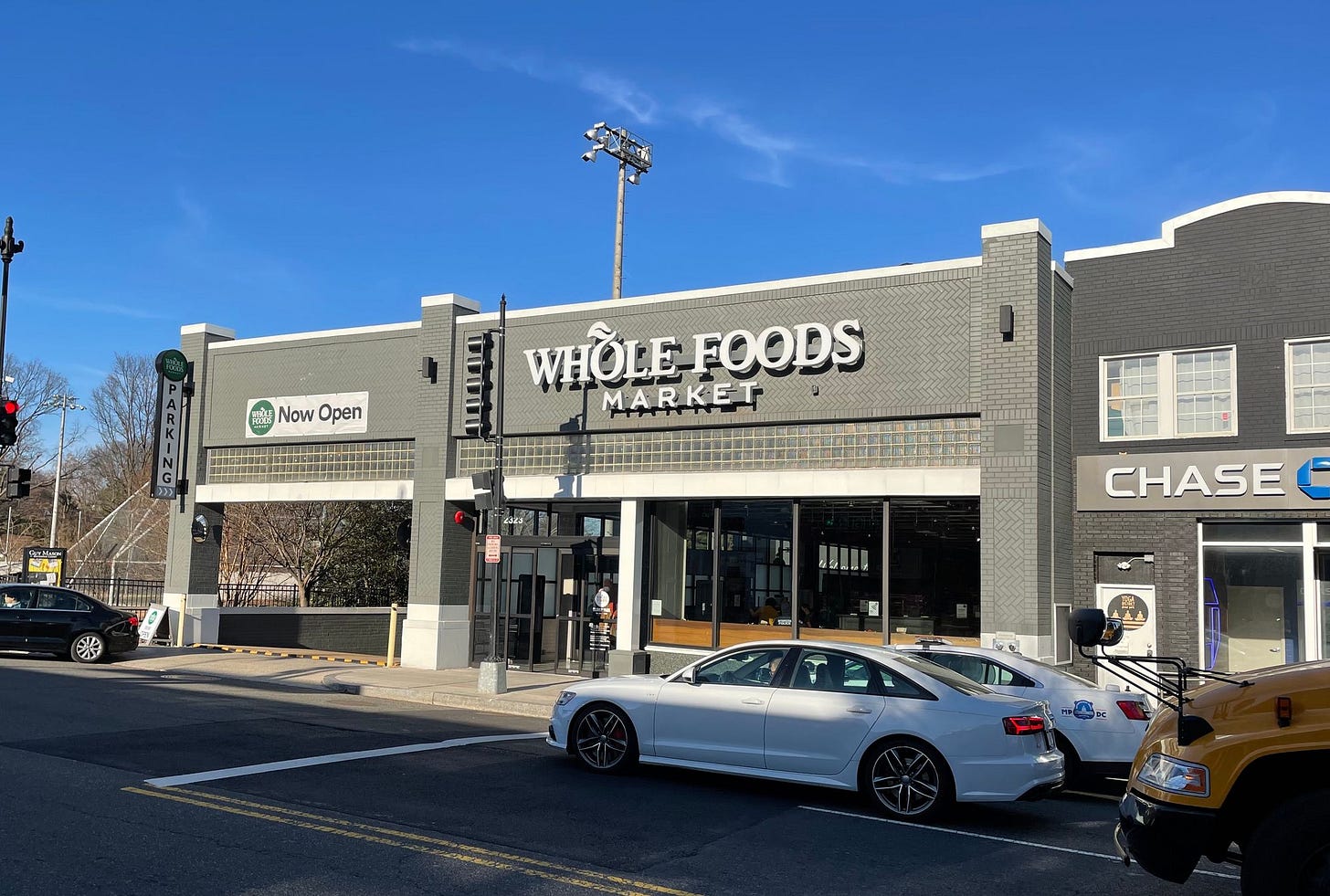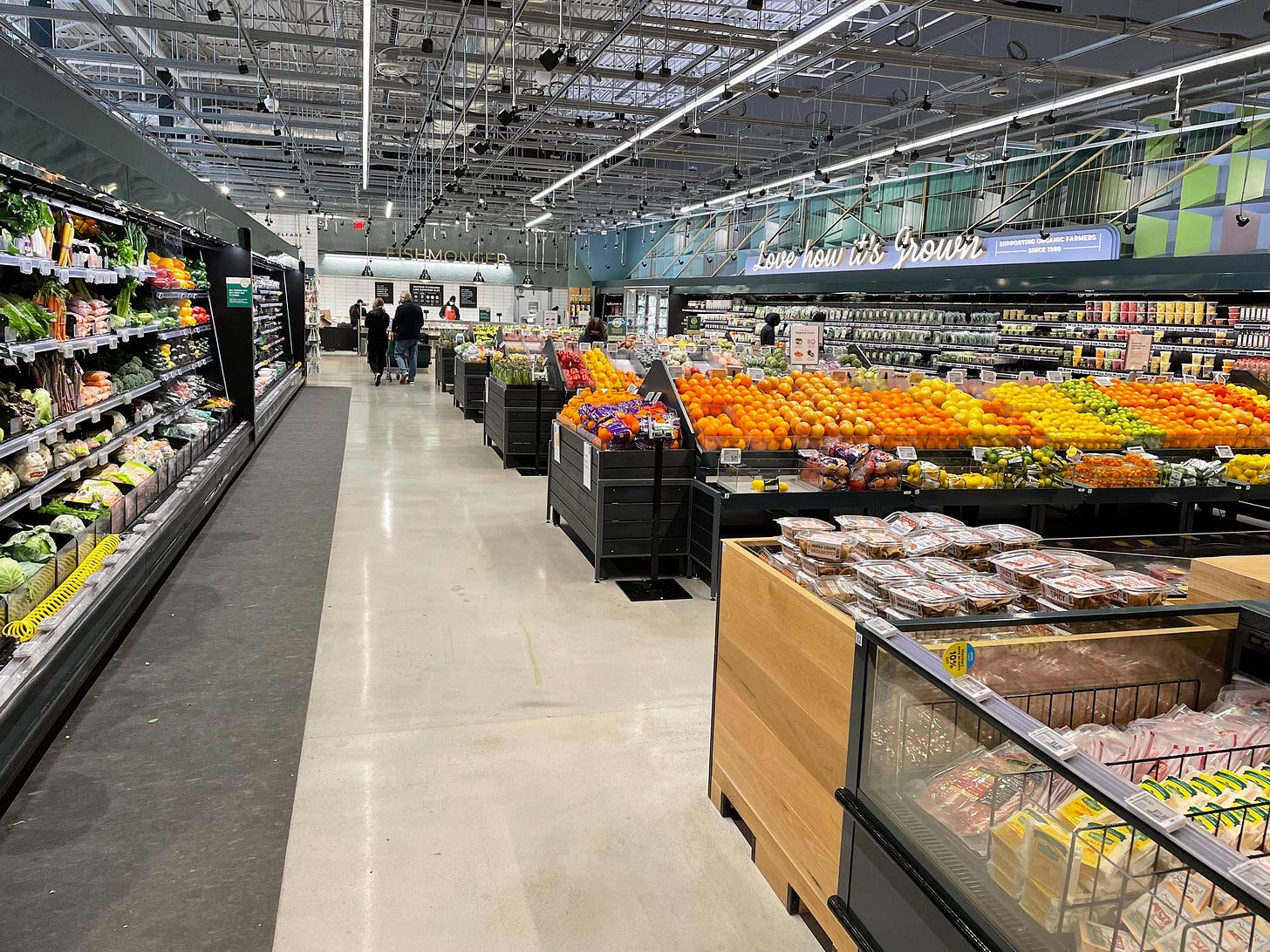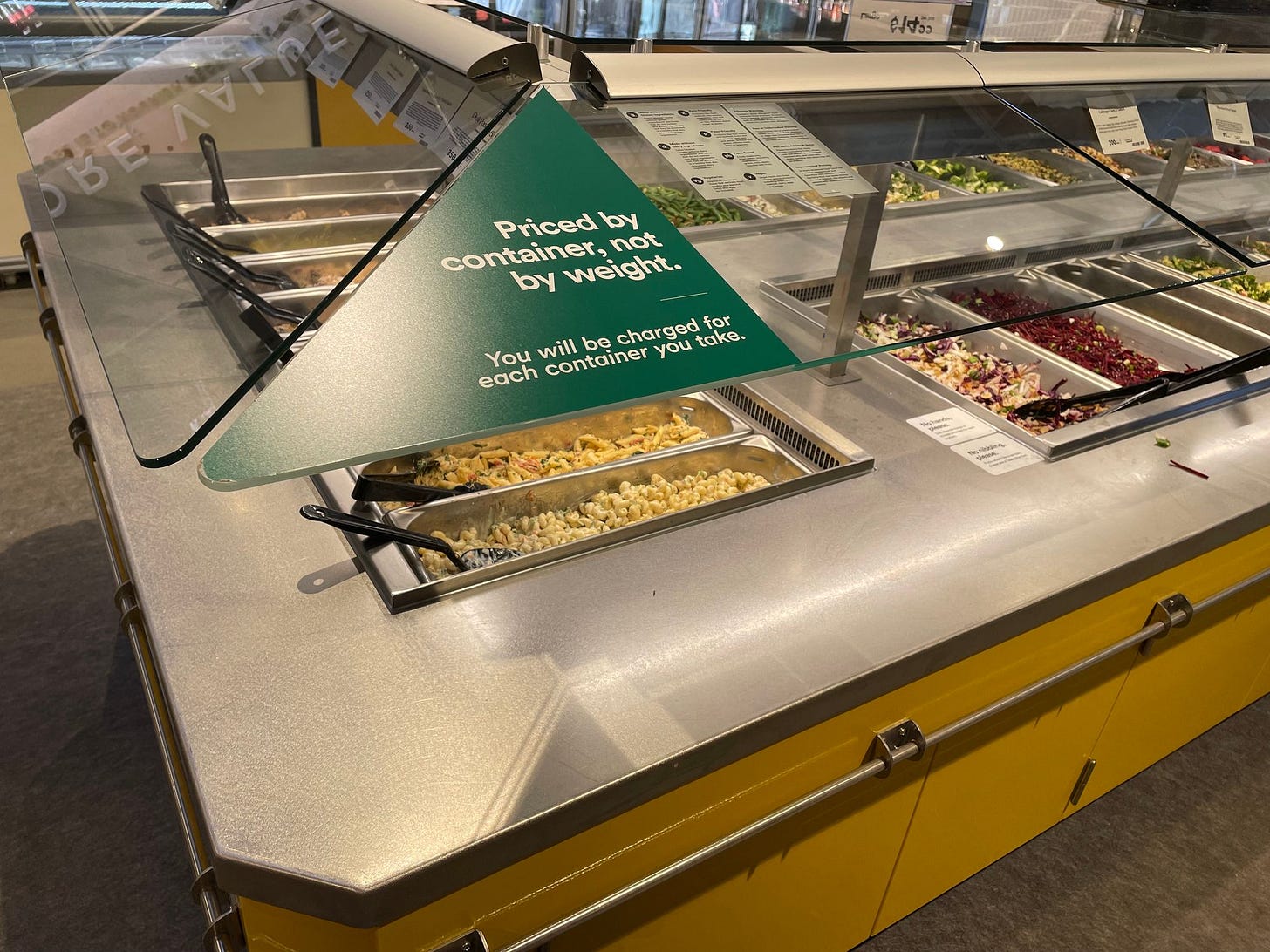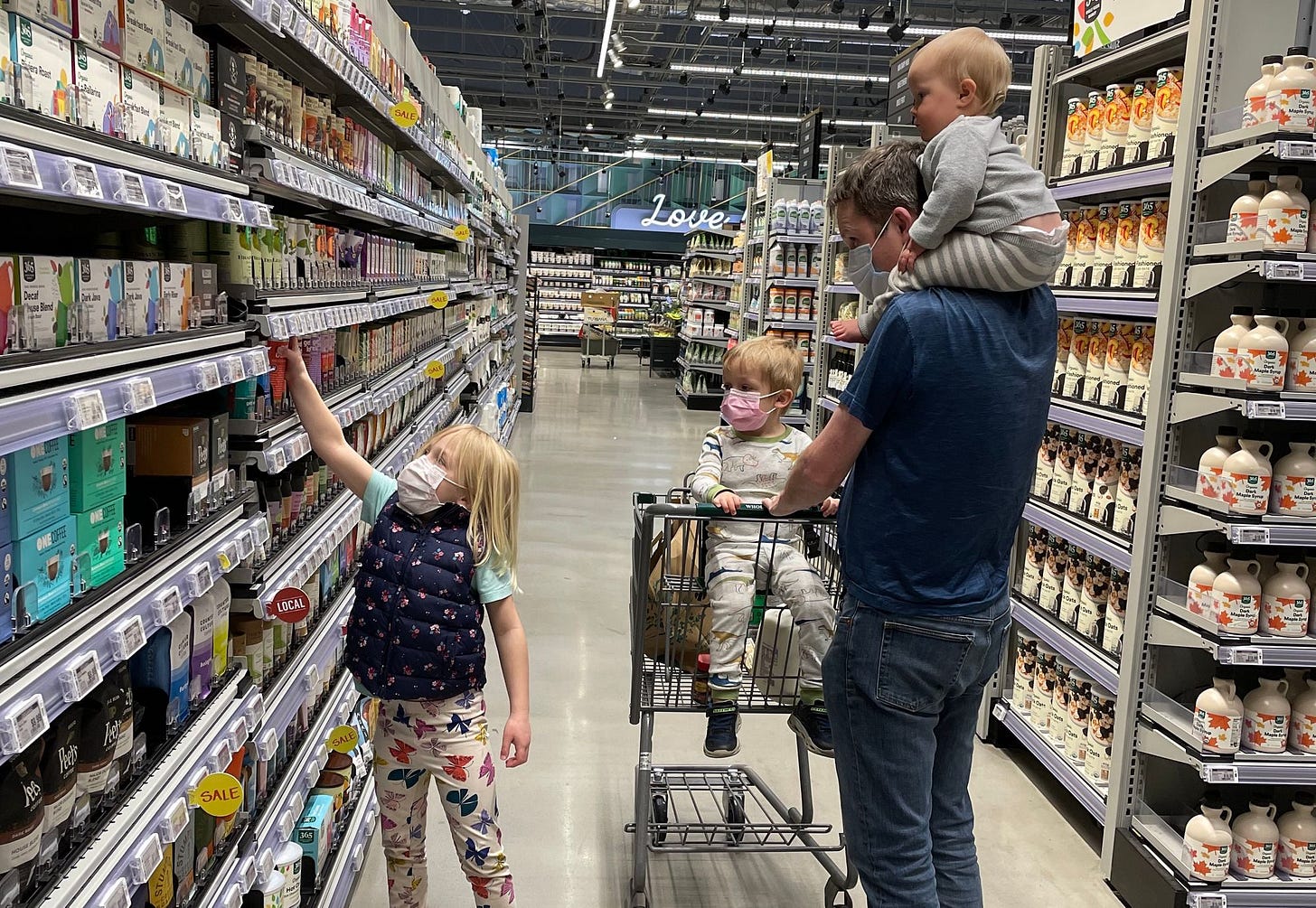I visited the first Whole Foods that lets you skip the checkout line
Amazon's Just Walk Out technology is a competitive threat to other grocery stores.
When I saw the news that Amazon was opening a Whole Foods location in Washington DC with Just Check Out technology, I knew I had to go see it for myself. Long-time readers may remember that my very first piece for Full Stack Economics last August was about the opening of an Amazon Fresh grocery store with this technology in Washington DC.
To use Just Walk Out technology, you identify yourself at the entrance using Amazon’s mobile app. Once inside, you shop normally: you take items off the shelves and put them in a regular shopping cart or basket. Cameras on the ceilings and scales on the shelves detect what you’ve taken. Then you “just walk out,” and Amazon’s AI software figures out what you took.
The Amazon Fresh store I visited last year was around 7,300 square feet—relatively small for a grocery store. At the time I wondered if Amazon was struggling to scale the technology up to a full-sized supermarket.
So last Friday, I traveled to DC’s Glover Park neighborhood to check out the first Whole Foods to feature Amazon’s no-checkout technology. I wasn’t disappointed.
A full-size supermarket
This Whole Foods location isn’t new. The previous incarnation of the store closed in 2017 “after health inspectors identified issues with rodents and pests,” in the words of the Washington Post. That led to a years-long legal dispute with the store’s landlord that was settled in 2020.
The store re-opened in February, and it has everything you’d expect at a Whole Foods location. There’s an extensive range of prepared foods, meat and cheese counters, and plenty of baked goods. The produce is excellent.
When I visited the DC Amazon Fresh store last year, I noticed that there were a lot of bare shelves. It seemed like the store had supply-chain issues it hadn’t entirely sorted out. The Glover Park Whole Foods didn’t seem to have this problem. Almost all the shelves were well stocked.
Whole Foods did make a few adjustments for the no-checkout approach. One big change was to avoid pricing items by weight. Bananas, for example, cost $1.19 for a six-banana bunch. A large grapefruit cost $1.69.
Whole Foods locations have buffets that allow a customer to serve themselves a hot meal. Most stores charge by weight, but that’s hard to do without a checkout process. So in Glover Park, the self-serve buffet is priced by the container. A small container costs $9.95, while a large one costs $14.95.
With no need to check out, I was able to bag my groceries in the cart as I moved through the store. That avoided any need to re-bag groceries before I left.
When I received my receipt about three hours after exiting the store, I found the technology had made a mistake. The receipt included a listing for “THAT'S TASTY Organic Basil.” I hadn’t taken any basil—tasty or otherwise.
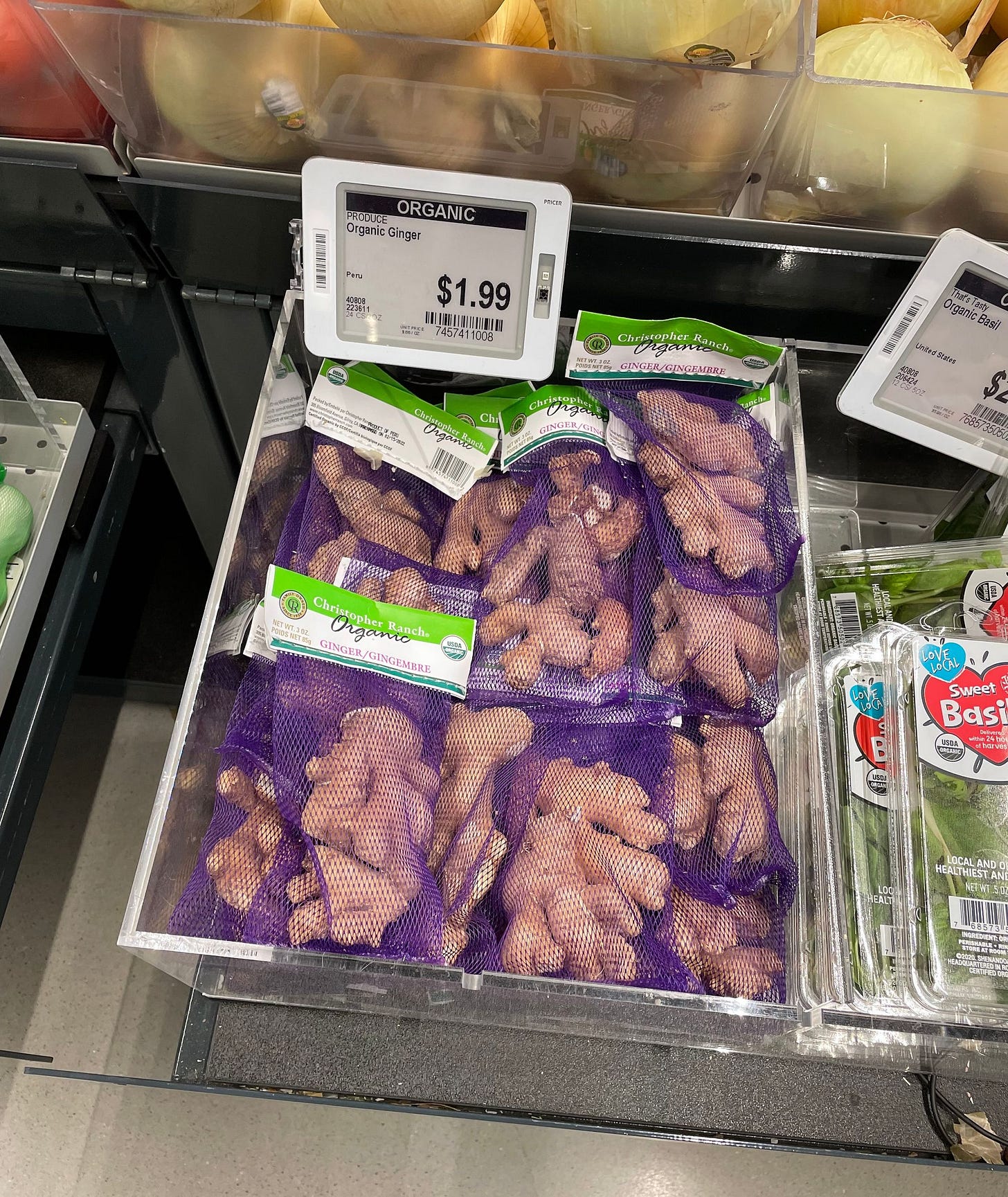
I’d taken photos of all my selections and I quickly figured out what had gone wrong. I had purchased a container of fresh ginger, which sat right next to the basil. Amazon hadn’t charged me for the ginger—presumably because it got it confused with the basil.
Luckily, it took just three clicks to tell Amazon that this charge was bogus, and my money was refunded with no hassle. I thought it was a little odd that Amazon didn’t give me a chance to tell them that they should have charged me for ginger instead. Not only could they have gotten more money that way, the feedback might help them improve their software.
“Just Walk Out technology is highly accurate," an Amazon spokesperson told me by email. "On rare occasions where a customer may find a discrepancy on their receipt, they can request a refund via the digital receipt in their email, or in the Whole Foods Market or Amazon app up to 30 days after their purchase.”
To be fair, this was one mistake out of 39 items. And the software hasn’t made any mistakes the other times I’ve used it. That includes multiple visits to the Amazon Fresh store last August. It also includes a return visit to the Glover Park Whole Foods on Monday with my wife and three kids. I thought having several people selecting items at once—and in some cases, passing items between us—might confuse the software. But the software correctly identified all 20 items we purchased on that trip.
Other grocery stores should take the Amazon threat seriously
The addition of Just Walk Out technology significantly improves the customer experience by allowing customers to skip the checkout lane. On top of that, it likely saves Amazon money by allowing them to hire fewer checkout workers. Wages for these workers is one of the biggest costs of any supermarket—8 to 10 percent of revenue, according to one expert—so being able to reduce headcount will be a big competitive advantage.
One of my big questions about Amazon’s technology is why they aren’t scaling it up more quickly. Amazon first employed Just Walk Out technology in Amazon Go convenience stores around 2018. Bloomberg reported in 2018 that Amazon was aiming to open 3,000 Amazon Go stores by 2021. They wound up opening a tiny fraction of that number.
But last August I noted that the number of those stores actually declined slightly from 25 to 22. Six months later, there are 24 now stores. Meanwhile, the number of Amazon Fresh locations (not all of which have Just Walk Out technology) has grown from 17 stores last August to 24 now, according to Amazon’s website.
“It doesn't seem like they're moving terribly quickly with stores,” said Patrick Fisher, a DC-based grocery industry analyst, in an interview last August. He noted that the German supermarket chain Aldi has been opening around 200 US stores per year in recent years.
Just Walk Out technology clearly works, and it will get better over time. Its benefits—both in customer experience and labor savings—are so compelling that it’s only a matter of time before it’s widely adopted.
But while the long-term potential is obvious, the short-term trajectory is uncertain. It takes a lot of work to squash the bugs, work out the economics, and build the infrastructure required to operate at scale. Employees at the Glover Park store told me that they’ve been testing the technology and undergoing training for months. Perhaps Amazon just doesn’t have the manpower to set up dozens or hundreds of stores simultaneously.
So it may be a few years before Amazon can bring grocery stores with Just Walk Out technology to every part of the country. But when they do, it’s going to be a serious competitive threat to other grocery stores.


